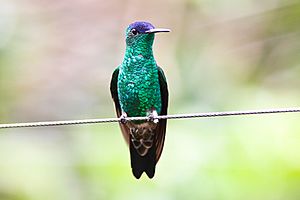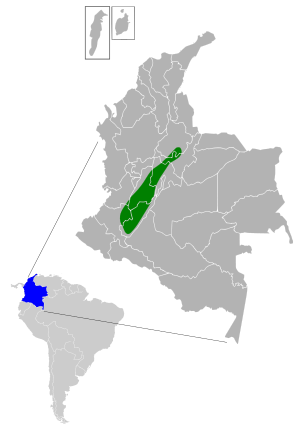Indigo-capped hummingbird facts for kids
Quick facts for kids Indigo-capped hummingbird |
|
|---|---|
 |
|
| Conservation status | |
| Scientific classification | |
| Genus: |
Saucerottia
|
| Species: |
cyanifrons
|
 |
|
| Synonyms | |
|
Amazilia cyanifrons |
|
The indigo-capped hummingbird (Saucerottia cyanifrons) is a small, colorful bird. It belongs to the group of hummingbirds known as "emeralds." This special bird lives only in Colombia, a country in South America.
Contents
About the Indigo-Capped Hummingbird
What's in a Name?
The indigo-capped hummingbird was once placed in a different group, or genus, called Amazilia. Scientists studied its DNA and found it fit better into a genus called Saucerottia. This change helps scientists understand how different bird species are related. The indigo-capped hummingbird is a unique species, meaning it doesn't have different subspecies.
What Does It Look Like?
This hummingbird is about 7 to 10 centimeters (about 3 to 4 inches) long. It weighs around 5 grams, which is super light! Both male and female birds have a black beak with a red base.
The adult male is quite striking. It has a bright indigo-blue cap on its head. Its upper body is a shiny green, turning a bronze or coppery color on its lower back. The feathers under its tail are a bronze-green or dark bluish with white edges. Its tail is a deep steel blue.
The adult female has a turquoise-blue cap towards the back of her head. Her throat feathers have a grayish bar. Young hummingbirds look similar to the female but have a grayer belly.
Where It Lives and What It Likes
Home Sweet Home
The indigo-capped hummingbird lives in northern and central Colombia. You can find it mainly in areas like the Magdalena River valley and the upper Cauca River valley.
Its Favorite Places
This hummingbird likes places that are partly open, like the edges of wet forests. It also lives in savannas, bushy areas, farms, and gardens. These places are usually quite dry. It's most common at elevations between 1,000 and 2,000 meters (about 3,300 to 6,600 feet). Sometimes, it flies down to 400 meters (about 1,300 feet) during breeding season. Rarely, it can even be seen as high as 3,000 meters (about 9,800 feet).
How It Behaves
Seasonal Journeys
The indigo-capped hummingbird seems to move to different elevations depending on the season. It does this to find flowering plants, which are its main food source.
What It Eats
This hummingbird eats nectar from flowers and small insects. It looks for food at all heights in its habitat, but mostly high up in the trees. Sometimes, many indigo-capped hummingbirds gather at flowering trees. However, they usually like to have their own feeding spots. They will defend these spots from other hummingbirds and birds that also eat nectar, like bananaquits.
It often catches insects by "hawking," which means it flies out from a perch to snatch insects in the air. Sometimes, it also picks insects off leaves.
Reproduction and Life Cycle
The breeding season for the indigo-capped hummingbird seems to be from April to at least July. They build a cup-shaped nest using moss, spiderwebs, and lichen. A female usually lays two eggs. Not much else is known about how they raise their young.
What Sounds It Makes
The indigo-capped hummingbird's song is a repeated, buzzy, squeaky sound. It sounds like "tzuk-keee ... tsrp." It also makes a high, sharp "tsit" call, sometimes several times in a row.
Its Conservation Status
The IUCN (International Union for Conservation of Nature) has listed the indigo-capped hummingbird as a species of "Least Concern." This means it's not currently in danger of disappearing. It lives in a fairly large area, and even though its exact population isn't known, scientists believe it's stable. There are no immediate threats to this bird. Its ability to live in many different types of places, including those changed by humans, suggests it is quite safe for now.
See also
 In Spanish: Diamante de frente azul para niños
In Spanish: Diamante de frente azul para niños


